Marina Spironetti goes in search of the perfect landscape view in the popular Tuscan city of Lucca…
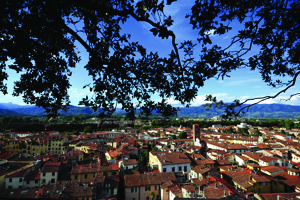 When I first went to Lucca I left with a feeling of pleasing quietness. The crowds that cram into nearby Pisa seemed to spare this gem of a city, apart from a small number of discreet visitors who were rather careful about not spreading the word. Upon my last visit, though, things seemed to have changed dramatically ? judging by the number of tourists strolling along its streets and piazzas, the secret has been revealed.
When I first went to Lucca I left with a feeling of pleasing quietness. The crowds that cram into nearby Pisa seemed to spare this gem of a city, apart from a small number of discreet visitors who were rather careful about not spreading the word. Upon my last visit, though, things seemed to have changed dramatically ? judging by the number of tourists strolling along its streets and piazzas, the secret has been revealed.
But my first impression did not change. Lucca is almost too perfect to be real. A dream city ? in its own restrained, homely kind of way. Writer Hilaire Belloc?s 1902 description of the city still holds true: ?The neatest, the regularest, the exactest, the most fly-in-amber town in the world, with its uncrowded streets, its absurd fortifications? everything in Lucca is good.?
Well, the streets might not be that ?uncrowded? anymore, but the ?absurd fortifications? are still standing proud. I therefore decided to begin my tour of the city with the customary walk along the mura, Lucca?s legendary 4km-long walls. Built during the 16th and 17th centuries, this stern fortification ? complete with 11 impregnable bastions ? was never properly tested. The ramparts were put to good use only in 1812, when they defended the city from flooding rather than invaders. With a height of 12m and a double row of trees planted on top, nowadays they are like an elevated garden boulevard. On one side is the centro storico and its glorious architecture, on the other is the lush Tuscan countryside, all the way to the peaks of the Apuan Alps in the distance. A hotspot for strolling, cycling and running, the mura also offer quiet shady corners, which are perfect for a picnic or ? why not ? a game of chess, as the elderly Lucchesi know well.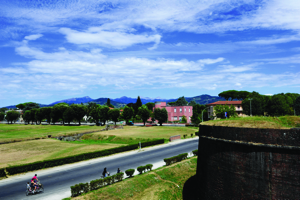
The Artistic Soul
Once you make your way inside, Lucca is a city made for the pleasure of wandering. The old town is a continuous surprise and every piazza you come across seems to exceed the one you just left behind. I entered from St Peter?s Gate, at the south end of the city near the train station, and headed for Lucca?s 11th-century cathedral, which resides in a quiet corner pleasantly secluded from the hustle and bustle.
Its architecture seems a little bizarre, if not somewhat unbalanced: a porch with three arches, each a different size, and a Lombard bell tower built before the rest of the Romanesque structure. Still, the Duomo di San Martino is probably the most outstanding work of the Pisan style outside Pisa itself. The dimly lit interior reveals a large tabernacle containing the Volto Santo (holy face), a painted wooden crucifix supposedly carved by Nicodemus, which allegedly represents the accurate face of Jesus. A major object of worship, it is marched through the streets of Lucca every 13 September in a solemn torch-lit procession. Other must-see artworks include the magnificent Last Supper by Tintoretto and the marble tomb of Ilaria del Carretto, a masterpiece of funerary sculpture by Jacopo della Quercia.
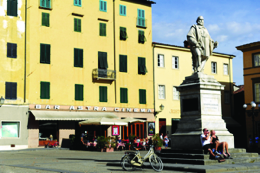 From the cathedral, Via Duomo takes me to Piazza Napoleone, Lucca?s main square. Its name is clearly a reminder of an important chapter in the city?s history: after Napoleon seized the city, he gave it to his sister Elisa Baciocchi, who patronised an intense ? if not too brief ? time of artistic ferment.
From the cathedral, Via Duomo takes me to Piazza Napoleone, Lucca?s main square. Its name is clearly a reminder of an important chapter in the city?s history: after Napoleon seized the city, he gave it to his sister Elisa Baciocchi, who patronised an intense ? if not too brief ? time of artistic ferment.
Heading north, the magnificent Piazza San Michele awaits. This is the spiritual heart of the city, dominated by the church, which bears the same name. Often mistaken for the cathedral, this impressive Romanesque church remains by far Lucca?s most beautiful sight. An ambitious fa?ade, rising well above the level of the roof, a blinding triumph of white marble where every single column is different from the other, according to the Pisan style; some doubled, some knotted, others carved into fantastical animals. And, above this alluring architecture, the graceful statue of Saint Michael stands tall, overlooking the busy crowds in the streets down below.
A Magical Atmosphere
East of San Michele, Via Fillungo is the focus of Lucca?s evening passeggiata as well as the city?s shopping artery ? a mix of fancy boutiques, restaurants and food shops selling every possible Tuscan delicacy, from cheese and wine to olive oil. And, yes, the famous Caff? di Simo. A coffee break there in Lucca?s most celebrated Belle Epoque caff?-pasticceria is customary, to say the least. It certainly has not changed much since composerGiacomo Puccini ? Lucca?s most famous son ? used to play piano there, and its long, polished bar offers plenty of sweets and pastries to satisfy those with a sweet tooth.
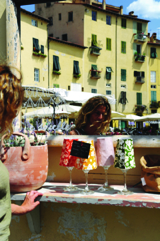 Halfway up Via Fillungo, a narrow arch to your right will lead you into Piazza dell?Anfiteatro, a reminder of Lucca?s ancient past (it came of age as a Roman municipium in 89 BC). The name is a bit misleading, as not a single stone remains from Roman times. As is the case with the city of Rome itself and many other cities attributed to the era, the stone was recycled, probably carted off for San Michele and the cathedral. Still, the outline of this amphitheatre is perfectly and beautifully preserved, with the arena where the gladiators used to fight now a breathtaking ellipse of yellow medieval houses. It?s best to head there in the evening, when the restaurants open up their elegant terraces for dinner and local children play freely on the pavement. A magical atmosphere, really ? Tuscany at its most charming.
Halfway up Via Fillungo, a narrow arch to your right will lead you into Piazza dell?Anfiteatro, a reminder of Lucca?s ancient past (it came of age as a Roman municipium in 89 BC). The name is a bit misleading, as not a single stone remains from Roman times. As is the case with the city of Rome itself and many other cities attributed to the era, the stone was recycled, probably carted off for San Michele and the cathedral. Still, the outline of this amphitheatre is perfectly and beautifully preserved, with the arena where the gladiators used to fight now a breathtaking ellipse of yellow medieval houses. It?s best to head there in the evening, when the restaurants open up their elegant terraces for dinner and local children play freely on the pavement. A magical atmosphere, really ? Tuscany at its most charming.
From Piazza dell?Anfiteatro, I then head to the Basilica of San Freudiano, which is only a short and pleasant walk away. Instantly distinguishable from the other Romanesque churches in town, it boasts a proud fa?ade with a lavish 13th-century mosaic in a Byzantine-like style. This overwhelming fresco depicts Christ?s ascension, painted in suitably rich colours. The interior is well worth seeing, especially for the delightful Fontana Lustrale, a richly carved baptismal font with sculpted reliefs, as well as a shrine to Lucca?s patron saint, Santa Zita.
Reach for the Sky
Lucca is also a city of towers. The startling skyline can be appreciated from the city walls: several lofty towers and campanili that make the city look like an old-time Manhattan. Having some energy left, I decided to climb up the Torre Guinigi, attracted by the unusual sight of looming oak trees growing out of its top.
The 14th-century stronghold of the Guinigi family is one of Lucca?s most beloved landmarks. The climb up its 230 steps is certainly worth the effort ? 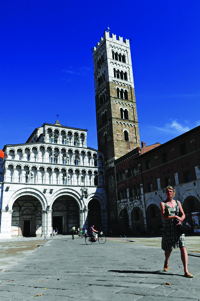 once you reach the top, you are rewarded with an amazing bird?s eye view of the city to the countryside beyond, all the way to the Apuan Alps, stretching to the very edge of the Tyrrhenian sea.
once you reach the top, you are rewarded with an amazing bird?s eye view of the city to the countryside beyond, all the way to the Apuan Alps, stretching to the very edge of the Tyrrhenian sea.
Enjoying Relaxation
My last treat in Lucca was Palazzo Pfanner, a scenic 17th-century palace where parts of the film adaptation for Henry James? Portrait of a Lady (with Nicole Kidman and John Malkovich) were shot. Felix Pfanner was an Austrian emigrant who was among the first ones to bring beer to Italy ? and brewed it in the mansion?s cellar.
Sadly, the brewery closed back in 1929 but the ornate 18th-century gardens are a real treat for the eye. Statues of the deities of Greek Olympus and the Four Seasons, hortensia bushes, ornamental flowers and earthenware pots of lemon trees are scattered all over. A fine example of Baroque elegance ? and the perfect place to sit down and read a book, in the welcome shade of a tree.
GETTING THERE
By plane – The closest airport is Galileo Galilei in Pisa, which is only 20km away. Easyjet (easyjet.com) flies there from Gatwick and Luton, while Ryanair (ryanair.com) offers a regular service from several UK airports, including Leeds, Liverpool and Edinburgh.
By bus – Buses into Lucca are operated by Lazzi (lazzi.it). Tickets can be bought in the tourist information office, found inside the airport.
